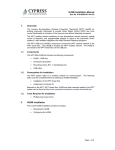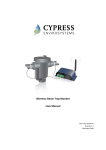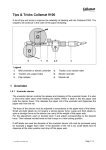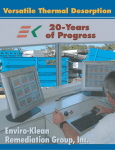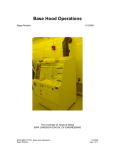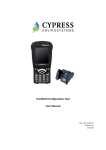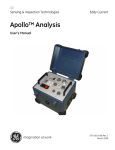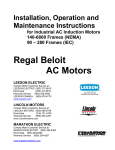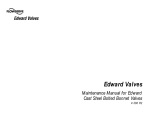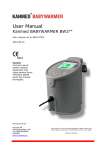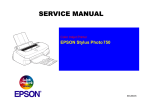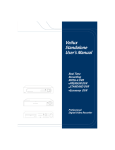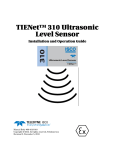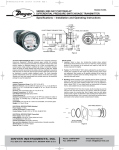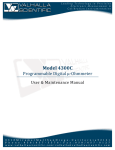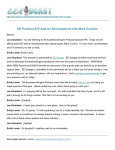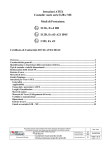Download airwall manual feb 2011
Transcript
SM AIRWALL® DUST COLLECTION SYSTEM INSTALLATION, OPERATION, MAINTENANCE AND REPLACEMENT PARTS MANUAL PUBLICATION NO. UM-AW-0211 Copyright 2011 ENVIROSYSTEMS, LLC 2555 N Coyote Dr. Suite 118 Tucson, AZ 85745 (520) 573-3064 (800) 999-0501 Copyright 2011 by Envirosystems Manufacturing, LLC All rights reserved, including those of translation. No part of this publication may be reproduced, stored in a retrieval system or transmitted in any form or by any means, electronic, mechanical, photocopying, recording or otherwise, without the prior written permission of Envirosystems Manufacturing, LLC, 2555 N. Coyote Dr., Suite 118, Tucson, Arizona 85745. TRADEMARK ACKNOWLEDGMENTS Envirosystems Manufacturing, LLC acknowledges the following companies and their trademarks that are used in this manual. Since the trademark information was derived from several sources, we cannot guarantee their accuracy. Photohelic is a registered trademark of Dwyer Instruments, Inc. AirWall and Envirosystems are registered trademarks of Envirosystems Manufacturing, LLC.. Information in this manual is subject to change without notice. IMPORTANT NOTICE This proprietary user's manual was prepared by Envirosystems Manufacturing, LLC (ES) for the exclusive use by its customers. The recommendations contained herein are based on proven techniques and also on test data believed to be reliable. It is intended that this manual be used by personnel having specialized training in accordance with currently accepted practice and normal operating conditions. Variations in environment, changes in operating procedures or extrapolation of data may cause unsatisfactory results. Since ES has no control over the conditions of service, it expressly disclaims responsibility for the results obtained or for any consequential or incidental damages of any kind incurred. TABLE OF CONTENTS TRADEMARK ACKNOWLEDGEMENTS . . . . . i TABLES OF CONTENTS. . . . . . . . ii LIST OF ILLUSTRATIONS/TABLES . . . . . . iii SAFETY SUMMARY . . . . . . S-1 . . . . . . . S-1 S-1 S-1 S-3 S-3 S-4 S-5 . . SAFETY PRECAUTIONS . . . . . . GENERAL SAFETY INSTRUCTIONS AND CONSIDERATIONS PERSONAL SAFETY . . . . . . WORK AREA SAFETY . . . . . . LIFTING AND CARRYING SAFETY . . . . SETUP AND OPERATION SAFETY . . . . MAINTENANCE SAFETY . . . . . . DESCRIPTION AND SPECIFICATIONS INTRODUCTION . . . . SYSTEM DESCRIPTION . . . FILTER CLEANING . . . . AIRWALL PRODUCT SPECIFICATIONS . . . . . . . . . . . . . . . . D-1 D-1 D-2 D-5 . . . . . . . . . . . . . . . . . . . . . . . . . . . . . . . . . . . . . . . . . . . . I-1 I-1 I-1 I-3 I-3 I-4 I-5 I-5 I-6 I-7 I-7 . . . . I-8 . . . . . . . . . . . . 2-1 2-1 2-4 INSTALLATION GENERAL INFORMATION . . UNCRATING AND INSPECTION . . POSITIONING FOR ASSEMBLY . . ELECTRICAL CONNECTIONS . . FILTER CLEANING SYSTEMS . . Integrated Control Panel . PNEUMATIC CONTROL CONNECTIONS COMPRESSED AIR CONNECTION . INSTALLING FILTER CARTRIDGES . INITIAL START UP PROCEDURE . Checking Fan Rotation . . Adjusting Photohelic Gage And Switch, On-Demand Cleaning Option . CCB Installation (IF APPLICABLE) GENERAL INFORMATION . ASSEMBLING THE CCB . ASSEMBLING THE AIRWALL UNIT . . . ELECTRICAL CONNECTIONS . . TIMER CONTROL BOARD . . COMPRESSED AIR CONNECTION . INSTALLING LIGHTING FIXTURES . SEALING CCB BEAMS AND SUPPORTS ELECTRICAL SCHEMATIC . . . . . . . . . . . . . . . . . . . . . . . . . . 2-5 2-7 2-9 2-11 2-12 2-13 . . . . . . . . . . . . . . . . . . . . . . . . . . . . . . . . . . . . . . . . . . . O-1 O-1 O-2 O-3 O-4 O-4 O-4 O-5 O-5 . . . . . . . . . . R-1 R-1 AIRWALL 60 THROUGH AIRWALL 100 MD’S. AIRWALL 100 THROUGH AIRWALL 160 HD’S. . . . R-1 R-2 OPERATION OPERATION PROCEDURE . FILTER CLEANING OPERATION. INTEGRATED CONTROL PANEL DUST COLLECTION DRAWERS . MOISTURE ACCUMULATION . CHANGING FILTER CARTRIDGES DUST COLLECTION DRAWERS . FAN MOTOR LUBRICATION . TROUBLESHOOTING . . . REPLACEMENT PARTS ORDERING REPLACEMENT PARTS REPLACEMENT PARTS LISTING LIST OF DRAWINGS INCLUDED WITH MANUAL AirWall Model MD AirWall Model HD PULSE SYSTEM WIRING DCT (D Size) SAFETY PRECAUTIONS These safety precautions have been prepared to assist the operator in practicing good shop safety procedures. These safety precautions are to be used as a guide and supplement to all other safety precautions and warnings in: a. all other manuals pertaining to machines, controls and auxiliary equipment. b. local, plant and shop safety rules and codes. c. federal and state safety laws and regulations. See the latest edition of the OCCUPATIONAL SAFETY AND HEALTH STANDARDS, available from the DEPARTMENT OF LABOR, WASHINGTON, D.C. __________________________________________________________ WARNING Read all the Safety Precautions in this chapter before operating the equipment. Failure to follow this precaution may result in severe bodily injury. __________________________________________________________ GENERAL SAFETY INSTRUCTIONS AND CONSIDERATIONS Machine owners and operating personnel must be aware that constant, day-to-day safety practices are a vital part of their job. Accident prevention must be one of the principal objectives of the job regardless of what activity is involved. Know and respect your machinery. Read and practice the prescribed safety and checking procedures. Make sure that everyone who works for, with or near you fully understands, and, more importantly, complies with the following safety precautions and procedures. PERSONAL SAFETY Avoid sudden movement, loud noises and horse-play. Distractions may result in unsafe conditions for those working near equipment. Equipment can and will cause extensive damage and/or injury if the practice of horse-play is not totally prohibited. Observe and follow safety instructions such as NO SMOKING, HIGH VOLTAGE and DANGER in your working area. Accidents can occur that result in serious injury to you or others due to clothing and other articles becoming entangled or in contact with revolving parts, levers and electrical equipment. a. Do not wear neckties, scarves or loose-fitting clothing. b. Do not wear jewelry such as bracelets, watches, rings or necklaces. Use safety protective equipment. An OSHA-NIOSH approved respirator must be worn at all times while blasting, changing filter cartridges, emptying dust collection drawers, and when handling media that contains free levels of silica and toxic material that are in excess of those allowed by applicable OSHA, USEPA, ACGIH or NIOSH regulations and recommendations. Wear clean, approved eye or face protection. Keep your protective equipment in good condition. Wear sturdy safety-toe shoes with slip-proof soles. The following chart lists the permissible noise level exposures for hourly duration. Permissible Noise Exposures Duration per Day, Hour 8 6 4 3 2 1 1/2 1/4 or less Sound Level dBa Slow response A Scale 90 92 95 97 100 105 110 115 Make sure the hearing protection is in good working order and replace as necessary. Wear hearing protection whenever you are in a noisy environment, such as a media blasting area, and when equipment is in operation. Noise from a blasting operation can exceed 120 dBa. See WARNING next page. __________________________________________________________ WARNING Wear hearing protection whenever you are in a noisy environment, such as a blasting area, and when equipment is operating. Failure to follow this precaution may result in severe bodily injury. __________________________________________________________ WORK AREA SAFETY Keep your work area clean. Dirty work areas with such hazards as oil, debris or water on the floor may cause someone to fall to the floor, into the machine or onto other objects, resulting in severe bodily injury. Make sure your work area is free of hazardous obstructions and be aware of protruding equipment components. Return tools and similar equipment to their proper storage place immediately after use. Keep work benches neat, orderly and clean. Report unsafe working conditions to your supervisor or safety department. Worn or broken flooring, ladders and handrails, unstable or slippery platforms or scaffolds must be repaired before use. Do not use skids, stock, media drums or boxes as makeshift climbing aides. LIFTING AND CARRYING SAFETY Contact supervision if you have any questions or are not sure about the proper procedures for lifting and carrying. Before lifting or carrying an object, determine the weight and size by referring to such things as tags, shipping data, labels and marked information or manuals. Use power hoists or other mechanical lifting and carrying equipment for heavy, bulky or hard-to-handle objects. Use hookup methods recommended by your safety department. Know and use the signals for safely directing a crane operator. See WARNING next page. If in doubt as to the size or type of lifting equipment, method or procedure for lifting, contact Envirosystems Manufacturing, LLC before proceeding to lift the equipment or its components. ___________________________________________________________ WARNING Never place any part of your body under a suspended load or move a suspended load over any part of another person's body. Before lifting, be certain that you have a safe location for depositing the load. Never work on a component while it is hanging from a crane or other lifting mechanism. Failure to follow this precaution may result in severe bodily injury or death. ___________________________________________________________ Always inspect slings, chains, hoists and other lifting devices prior to use. Do not use lifting devices, which are defective or questionable. Never use lifting devices, which have been painted as the paint, can hide stress or fatigue cracks. Never exceed the safety rated capacity of cranes, eyebolts, hoists, slings or other lifting equipment. Follow standards and instructions applicable to any lifting equipment used. SETUP AND OPERATION SAFETY Do not set up or operate any machine until you read and understand all safety instructions. Assign only qualified, fully trained personnel, instructed in safety and all machine functions, to operate any equipment. Operators must carefully read, understand and fully comply with all machine-mounted warning and instruction plates. Do not paint over, alter or deface these plates. Replace all plates, which become illegible Do not operate machinery with safety guards, shields, barriers, covers or other protective devices disconnected, removed or out of place. Interlocks are provided for various units. Do not remove or bypass them. Never lean on a machine or reach over or through a machine. You may become caught between moving elements or you may accidentally activate start buttons or similar devices. Be attentive during operation. Excessive vibration, unusual sounds, etc. can indicate problems requiring your immediate attention. System power must be off if the equipment is left unattended. Shut off power to a machine when you leave the operating area or at the end of your work period. Never leave the machine running unattended. Make sure system power is off before cleaning any machinery. Working space around electrical equipment must be clear of obstructions. Provide adequate illumination to allow for proper operation. MAINTENANCE SAFETY Do not perform maintenance on this machine until you read and understand all the safety instructions. Assign only qualified service or maintenance personnel to perform maintenance and repair work on this machine. Consult the maintenance sections in this manual before starting any service or repair work. When in doubt, contact Envirosystems Manufacturing, LLC, Tucson, Arizona. Before removing or opening any electrical enclosure, cover, plate, or door, make sure the main disconnect switch is in the OFF position. Post a sign at the disconnect switch indicating that maintenance work is being performed. Working space around electrical equipment must be clear of obstructions. Provide adequate lighting to allow for proper operation and maintenance. Before working on electrical circuits, turn the main disconnect switch OFF and lock it. When removing electrical equipment, place numbered or labeled tags on those wires not marked. If wiring is replaced, make sure it is of the same type, length, and size and has the same load carrying capacity. An electrical technician must analyze the electrical system to determine the possible use of power retaining devices such as capacitors. Such power retaining devices must be disconnected, discharged, or made safe before maintenance is performed. Unless expressly stated in applicable Envirosystems Manufacturing, LLC documentation or by an Envirosystems Manufacturing, LLC representative, do NOT work with electrical power "ON". If such statement or advice exists, working with electrical power "ON" should be performed by an Envirosystems Manufacturing, LLC representative. The user must determine that any other person performing work with electrical power "ON" is trained and technically qualified. See DANGER: HIGH VOLTAGE next page. __________________________________________________________ DANGER: HIGH VOLTAGE Before working on any electrical circuits, turn the machine main disconnect switch "OFF" and lock it. Unless expressly stated in applicable Envirosystems Manufacturing, LLC documentation or by an Envirosystems Manufacturing, LLC representative, do NOT work with electrical power "ON". If such statement or advice exists, working with electrical power "ON" should be performed by an Envirosystems Manufacturing, LLC representative. The user must determine that any other person performing work with electrical power "ON" is trained and technically qualified. Failure to follow this precaution may result in severe bodily injury or death. __________________________________________________________ INTRODUCTION The AirWall dust scrubber is a stand-alone unit that may be installed in an existing location or as part of a new piece of equipment. Capacities range from 10,000 to 30,000 cfm per unit for standard modules. Custom configurations can provide filtration capacities over 100,000 CFM. Standard Specifications are listed at the end of this chapter. Because of the cfm capacity range, the AirWall Scrubber units can be configured to meet required linear air flows for practically any equipment or space ventilating requirement SYSTEM DESCRIPTION The AirWall Scrubber is designed with large inlet and outlet plenums, resulting in low static pressure requirements. This allows the use of relatively low horsepower motors and low decibel level blowers. This results in cost efficient ventilation of large, dusty environments found in tunneling and mining operations. Incoming air passes through the protective baffles on the front inlet where large or heavy particles are stopped to prevent filter damage. The dust-laden air then passes through the filter medium from the outside to the inside of the filter cartridges and out the open top of each cartridge. This leaves the dust on the out-side surface of the cartridges. The filtered air then flows from the cartridges into the clean-air plenum above the filter cartridges where it is pulled out of the unit to the fan. Options for the AirWall dust collection unit include: 1. Time delayed cleaning feature to provide automatic reverse pulsejet cleaning of filter cartridges during non-working hours. 2. Integrated control panel including disconnect, motor starter(s), control transformer, Photohelic gage and switch, and indicator lights. Up to four (4) AirWall Scrubbers may be controlled from the central control panel. 3. Hoppers for use with screw or a pneumatic conveying duct to transfer dust to a central collection point. 4. HEPA (High Efficiency Particulate Air) filter package. Each AirWall Scrubber can provide filtration for a variety of dust or other airborne contaminates, removing sub-micron particles at a high efficiency rate. This allows the exhaust air to be redirected back into the workplace for exhausting though the standard ventilation system without contamination of surrounding areas. FILTER CLEANING Filter cleaning is accomplished by actuating a short burst of air that blows back-ward from the clean side of the cartridge. This dislodges the caked dust that then drops into collection drawers or optional dust collection hoppers. Each pulse cleans two to six filter cartridges, depending on scrubber type, leaving the remaining cartridges available to continue filtering the ventilation air. This allows the cleaning to take place without the need to stop the air ventilation system. Descriptions of certain main filter cartridge cleaning system components are as follows: 1. Pulses of compressed air automatically clean the cartridges by reverse pressurization. A preset solid state timer with digital display, controlling both frequency and duration of the pulses, controls cleaning. A pressure transducer monitors differential pressure across the filter section. When the pressure differential reaches a pre-set value, the reverse pulse system will automatically dislodge dust from the cartridges using compressed air stored in an integral header tank inside the clean air plenum. Since the header tank is protected from uv and moisture the service life of the reverse components is several time longer than competitors units where the header tank is mounted externally. 2. Timer Control Board. This solid state device controls the cleaning cycle of the filter cartridges. When the pre set pressure differential setting has been reached, an output signals the timer control board to start the cleaning cycle. The timer control board then initiates a series of timed pulses, cleaning a single row of filter cartridges with each pulse. This sequence starts left-to-right (facing the air inlet). The length of each pulse is adjustable from .05 to .5 second with the normal pulse time being 0.3 second. A time delay between each pulse allows the air accumulator tank to recharge for the next pulse. This delay is adjustable between 8 and 180 seconds with the normal delay for the standard system being 8 seconds. During the cleaning cycle, the controller will pulse each set or filter cartridges in turn until the pressure differential drops below the LOW set point. When the LOW set point is reached, the cleaning cycle stops until the HIGH set point is again reached. The timer control board’s memory feature remembers which filter cartridge set was the last one cleaned. The next cleaning cycle will start with the next filter element in line. This feature ensures that all filter cartridges receive the same cleaning regardless of their position in the cycle. A optional manual on/off switch is also available and, when installed, allows the pulse system to be activated at any time, whether or not the fan is running. This allows periodic deep cleaning of the filter cartridges and will extend filter life. This option should be monitored when used to prevent accumulated dust being forced backward down the dirty air inlet and out into the workspace. Air Pressure A 3. this tank. The entire capacity is released in one (1) pulse each time one of the diaphragm valves is opened. Some Scrubber models will have more than one accumulator tank. Solenoid Valv 4. releases a small amount of pressure, allowing a control diaphragm to depressurize and open a 1 in. diameter valve. Each pilot solenoid is energized in turn by the timer control board. 5. Diaphragm Valves. There are three (3) or five (5) pilot-operated diaphragm valves in each AirWall Scrubber. When the pilot solenoid releases the diaphragm pressure holding the valve closed, the valve snaps open, immediately releasing the contents of the air accumulator tank through the opening in the valve and into a pulsejet blow pipe. 6. Pulsejet Blow Pipe. Each pulsejet blowpipe, located in the upper AirWall frame, contains two (2) or three (3) orifices, depending on scrubber type. These orifices are positioned above, and directed into, the opening of the filter cartridge through the tube sheet. As the pulse of air reaches the filter cartridge opening it travels down the entire length of the inside of the filter cartridge, dislodging the dust from the filter cartridge. AIRWALL SPECIFICATIONS Model AWC 2S Unit Dimensions Height (Excludes Blower Height) Inch (mm) 66 (1676) Width Inch (mm) 57 (1448) Length Inch (mm) 208 (5283) Filter cartridges (Standard) No. Total Filter Area Sq. Ft. Spunbond 20 80/20 20 2400 6000 Air Requirements Pulse Air Supply: 3.0 CFM @ 90 – 100 psi (6,2 – 6,9 bars) Electrical Requirements Pulse System: 2A@ 120 VAC, 1-Phase, 60 Hz GENERAL INFORMATION The AirWall dust collection unit will arrive disassembled for shipment and must be reassembled by the customer or his agent. Unit assembly, with the exception of the electrical and air connections, can usually be accomplished by anyone with a basic understanding of common hand tools. Besides a common set of hand tools, a forklift or chain-fall will be required to position the fan and motor on top of the AirWall unit clean-air plenum. NOTE: Envirosystems Manufacturing, LLC (ES) must rely on the skill and expertise of its customers and the customer’s installation contractor to ensure that all electrical connections are made correctly and air connections and regulation devices are installed and operating properly. UNCRATING AND INSPECTION The AirWall unit and related components are shipped on separate skids and some of these components may be drop shipped directly from an approved ES vendor to shorten delivery time. NOTE: Use extreme care when handling the unit and components. Careless handling can damage delicate parts or affect alignments. Compare the number of items received against the carrier’s Bill of lading. Inspect all items for apparent damage. Immediately report any shortages or obvious damage to the carrier and to ES. NOTE: Do not return any damaged components without first contacting ES. POSITIONING FOR ASSEMBLY 1. Position the AirWall unit filter section where it will be permanently located. 2. Check all setscrews and bolts on the exhaust fan/motor assembly to make sure they have not loosened in transit. If necessary, retighten the setscrews and bolts. 3. Rotate the fan impeller by hand to make sure it has not shifted in transit or been damaged during shipment. 4. Open the access door, located in the clean-air plenum, above the inlet baffles on the front of the AirWall unit. 5. Apply a bead of sealant around the fan inlet opening on top of the cleaning plenum. 6. Use a forklift or chain-fall to lift the exhaust fan and motor assembly into position on top of the filter cartridge section clean-air plenum. See CAUTION. CAUTION Do not hoist the fan-motor assembly by lifting on the fan or shaft. Failure to follow this instruction may cause damage to the fan/motor components. 7. 8. Position the fan exhaust pointing off any one of the four sides. If the exhaust is to be pointed off the side of the AirWall unit, the front and rear clearance will change depending on which side the exhaust is pointed. Align the mounting holes in the fan/motor assembly with the mounting holes in the top plate of the clean-air plenum. 9. Use the 2 1/2” bolts, flat washers, and flange nuts to secure the assembly firmly into place. Wipe away any sealant, which may have squeezed out. 10. If HEPA (High Efficiency Particulate Air) filters have been specified, attach them at this time. General instructions are as follows: a. Apply sealant, or a closed-cell foam gasket material, to the flange attachment surface on the inlet side of the safety filter assembly. Attach the transition duct, using the duct flange doublers provided. b. Move the filter assembly, together with any required transition ducting up to the rear of the AirWall unit. Align the open end of the transition ducting with the fan exhaust duct flange. Apply sealant or a closed-cell foam gasket material to the fan exhaust flange-mating surface. NOTE: In reference to Steps A and B, neither a support platform nor a transition duct is provided due to differences in facility installation. c. Open the access doors. d. Slide the pre-filters into the slots provided. Make sure the air flow direction is correct. e. Install the HEPA or safety filter on the back wall of the filter stand. The gasket will seat on the metal frame. Once the filter is in place, swing the locking bolts into position so that the locking bolts hook on the edge of the filter corners. f. Evenly tighten all four (4) corners to 29 in. lbs. (3,3 Nm). g. Close the access doors. Position the positive sealing latches on both sides of the access doors and tighten to provide a 50 percent gasket compression. NOTE: Refer to the HEPA filter manufacturer’s product documentation for specific information regarding your HEPA application or installation. ELECTRICAL CONNECTIONS The electrical requirements for the exhaust blower motor are 208/230/460 VAC, 3phase, 60 Hz power. Only a qualified electrician should connect this device to an appropriate motor starter. NOTE: Whenever possible, EECI attempts to deliver the fan motor wired for your specific voltage requirements. It is recommended, however, that your electrician verify the motor terminal connections to ensure proper wiring for your installation. The electrical requirements for the Photohelic gage and switch are 120 VAC, single phase, 60 Hz. Only a qualified electrician should make the connection of this device. FILTER CLEANING SYSTEMS With the standard filter cleaning system, the reverse pulse is released from the diaphragm valve by the solenoid pilot valve, which is activated in turn by the timer control board. On-Demand Filter Cleaning System. A Photohelic gage and switch are used to initiate the filter cleaning sequence. This unit is a sophisticated and sensitive device. Therefore, any questions regarding the electrical connection of this device should be referred to EECI at 1-800-999-0501 before proceeding. Refer to the electrical schematic labeled “Pulse System Wiring” provided with this manual. Do not connect circuit test equipment to the timer control board. See CAUTION. CAUTON Do not connect circuit test equipment to the timer control board. The use of certain types of test equipment can seriously damage the timer control board components. Failure to follow this instruction will void the warranty. 1. EECI recommends that the timer control board be mounted next to the AirWall unit, or within 4 to 6 ft. of the unit. 2. The common (white) lead, along with wires numbered 1 through 5, have been pre-wired into the junction box located on the AirWall unit. Leads in this junction box are numbered 1 through 5, with an additional common (white) lead. Run these leads through suitable conduit into the Photohelic control panel. Since the distance from the junction box to the Photohelic control panel is not known for your installation, this cable is not supplied. 3. From the junction box, connect wires 1 through 5 to terminals 1 through 5 on the timer control board. 4. Connect the common lead (white) from the AirWall unit to the common terminal on the sequence controller board. These connections allow the timer control board to energize the solenoids inside the AirWall unit cleanair plenum, which in turn opens the diaphragm valves and pulses the filter cartridges. 5. Connect the positive (hot) lead from 120 VAC to L1 on the Photohelic control card. 6. Connect the common lead (white) from 120 VAC to L2 on the Photohelic control card. 7. Connect the ground (green) lead to the ground terminal provided in the timer Control board box. Integrated Control Panel. The electrical requirements for the integrated control panel are 208/230/460 VAC, 3-phase, 60 Hz power. Only a qualified electrician should connect this device to an appropriate protected power source. If your AirWall unit has this optional control panel, the electrical schematic will be supplied with the manual. PNEUMATIC CONTROL CONNECTIONS In addition to the electrical connections, two (2) pneumatic control connections must be made from the AirWall unit to the Photohelic Gage. These connections should be made with ¼ in. (6mm) nylon poly tube. To complete the pneumatic control connections: 1. Push the 1/4 in. (6mm) tubes into the brass bulkhead quick-disconnect fittings located on the AirWall unit. 2. Connect these two (2) lines to the Photohelic gage as follows: a. Connect the high-pressure tube from the Photohelic gage to the lower port on the AirWall unit. b. Connect the low-pressure tube to the upper port on the AirWall unit. COMPRESSED AIR CONNECTION The air pressure accumulator tank located inside the AirWall upper air plenum should be supplied with clean, dry compressed air between 90 and 110 psi. Total air consumption is variable and is dependent on the type and concentration levels of airborne dust and the set points used for determining the cleaning cycle. Typical air consumption will be approximately 1.8 CFM per AirWall unit. Use the following procedure to complete the compressed air connection. Although the AirWall unit is designed for a 1 in. NPT supply line, the supply line may be smaller than 1 in. but should not be smaller than .375 in. or excessive accumulator recharge time will result. The 1 in. coupling in the tube sheet may be bushed for smaller air supply lines. NOTE: Since each customer installation is different, EECI has not cut the hole through the AirWall unit which is necessary for the installation of the air supply line. 1. Cut a hole in the side of the dirty-air (lower) plenum bulkhead sufficient in size to accommodate the supply line diameter. 2. Externally mount a shut-off valve with a nipple or stub pipe extending through the hole and connect the pipe to the fitting provided in the bottom of the tube sheet. This connection is positioned between the back two rows of filter openings. 2. 3. Connect an air hose or hard plumbing from the compressed air source to the shut-off valve on the side of the AirWall unit. 4. Slowly open the shut-off valve to allow pressure to build in the accumulator tank. When the tank has reached full line pressure of 90 to 110 psi, close the shut-off valve. 5. Inspect the tank, valves and fittings, including the solenoid valves inside the cleaning system control box, for air leaks. 6. Tighten fittings and clamps as required. 7. Reopen the air shut-off valve. INSTALLING FILTER CARTRIDGES 1. Remove the filter cartridges from their boxes. Inspect for damage. 2. Locate the support rod assemblies. 3. Carefully guide the threaded rod of the support rod down through the filter cartridge and through the center hole in the bottom of the cartridge. Place a filter cartridge retaining nut on the threaded end of the support rod. 4. Beginning with the back row, gently lift the filter cartridge and position the hooked end of the support rod in the hole in the spider assembly welded in the opening of the tube sheet. The short, right-angle bend in the support rod will keep the support rod from turning completely around when it is positioned in the spider assembly. 5. With the spider assembly centering the filter cartridge in line with the tube sheet hole, guide the cartridge up against the spider assembly by tightening the filter cartridge-retaining nut on the end of the support rod. 6. While ensuring that the filter cartridge is aligned with the hole in the tubesheet, tighten the filter cartridge-retaining nut enough to compress the seal and test by making sure the filter cartridge can no longer be rotated by hand. 7. Repeat this procedure for the entire back row of filter cartridges. 8. Make one last inspection of all filter cartridges in the completed row for proper alignment and tightness before proceeding to the next row. 9. Proceed to the next row and repeat the procedure for the entire row of filter cartridges. 10. Again, make one last inspection of all filter cartridges in the completed row of filter cartridges. 11. Install the inlet baffles on the front of the AirWall unit by lifting and hanging the baffle assemblies. Make sure the support lip on the top of the baffle assembly interlocks with the lip on the top of the air inlet opening. 12. Install the dust collection drawers in the base of the AirWall unit. INITIAL START UP PROCEDURE ___________________________________________________________ WARNING Wear clean, approved eye or face protection while performing the initial start up procedure. Failure to follow this instruction may result in serious personal injury. ___________________________________________________________ Checking Fan Rotation Use the following procedure to check the fan rotation. With the elec 1. turning on the AirWall unit. As the fan coasts to a stop, visually inspect the fan exhaust outlet and ensure that the fan rotation is in the correct direction. See WARNING. __________________________________________________________ WARNING Never place hands or other objects such as tools into the fan inlet or exhaust openings. Failure to follow this instruction may cause serious personal injury. __________________________________________________________ Normally, there is an arrow on the blower indicating proper rotation of the fan blades. If this arrow is not visable carefully look into the fan exhaust outlet and confirm that the fan blades are moving toward you. If the fan blades are rotating away from you, have your electrician reverse the motor direction. 2. After assuring that the fan is turning in the proper direction, restart the AirWall unit and allow it to come up to speed. Ask your electrician to use an amp probe or ammeter to take amp and volt readings after the fan has rotated up to full speed to make sure the motor is not being overloaded. Adjusting Photohelic Gage And Switch It may be necessary at this time to adjust the Photohelic gage and switch to ensure its proper operation. 1. With the fan off, check the black needle on the gage to determine the reading. If the needle is indicating more than, or less than zero, it must be adjusted. 2. To adjust the gage, use a small straight blade screwdriver to carefully turn the small adjusting screw located on the front of the gage face. Turn the screw slowly one way or the other to achieve a zero reading. 3. With the fan on, check the Photohelic gage and note the needle indica-tion. A reading of approximately plus 0.5 or minus 0.1 is normal for new filters. 4. Use the small knob on the lower left of the gage face to set the left or "low point" needle to 2.0. Use the knob on the right to set the right or "high point" needle to 2.5 on the gage. NOTE: The system is now operational. As the filter cartridges become "seasoned", it may be necessary to re-adjust the set-points. This is usually apparent when the cleaning cycles become more frequent. The adjustment involves changing the low set point to 2.2 to avoid over-cleaning the filter cartridges. OPERATIONS _________________________________________________________ CAUTION Avoid mixing combustible dust with dust from spark generating operations, such as ferrous or non-ferrous material grinding operations. Under no circumstances should lighted cigarettes, etc. be permitted to enter the air inlet or dust collection drawers of the AirWall unit. Failure to follow this instruction may result in severe damage to the equipment and personnel injury. _________________________________________________________ Filter Cleaning Operation The filter cleaning system uses compressed air to back flush or pulse accumulated particulate from the cartridge pleats. A timer control board starts the cleaning sequence. The system begins cleaning the filters anytime the pressure differential between the entrance (dirty) side of the filter cartridges and the exit (clean) side reaches a pre-determined level. This differential is constantly monitored by a Photohelic gage and switch or digital pressure sensing module. As the filter cartridges become more restricted by dust accumulation, the exhaust fan creates a greater vacuum or pressure drop in the clean air plenum on the clean side of the filter cartridges. The Photohelic gage or digital sensing module monitors this vacuum and, as the pre-determined high set point is reached, reverse pulse cleaning cycle is started automatically. At the start of the cleaning cycle, a time delay of approximately 8 seconds will elapse. This is referred to as the "off time" and is the time necessary between pulses for the pressure accumulator to recharge for the next pulse. At the end of the "off time," a pilot solenoid will release the pressure on a diaphragm valve and a short burst of air will be transmitted through an orifice in a blow-pipe located above each of the rows of filter cartridges. The AirWall LD models have 3 blow-pipes, while the AirWall MD and HD models have 5 blow-pipes. The air pulse will cause a shock wave to blow backward through the filter cartridge. This dislodges the accumulated dust, which falls into dust collection drawers at the bottom of the AirWall unit. The pulse time is adjustable from .05 to .5 seconds in duration and is referred to as the "on time". Normal pulse time is 0.3 second. The cleaning cycle will continue with an "off time" and "on time", producing a full pulse each time, until the Photohelic gage or digital sensor module registers a pressure drop sufficient to stop the cleaning process. This is pre-determined and is referred to as the low set point. The high and low set points can be adjusted using the two adjustment knobs located on the front of the Photohelic gage or the keypad on the digital sensor module. Adjustments can be made as required to accommodate various process variables and to maintain the filters at their optimum efficiency. Integrated Control Panel (ICP). An optional NEMA 12 ICP is available with controls for starting up to four (4) AirWall unit’s along with their on-demand filter cleaning controls. These controls include: MAIN POWER - Disconnect switch PURGE CONTROL - OFF indicator light and MAN/OFF/AUTO selector switch FAN MOTORS - RUN indicator light and START/STOP selector switch FILTER PRESSURE - Photohelic gage and switch or digital sensor module MAIN POWER This switch provides on/off switching and over-current protection for the Integrated Control Panel PURGE CONTROL The FILTER PURGE controls consist of the OFF indicator light and the MAN/OFF/AUTO selector switch. The MAN/OFF/AUTO selector switch controls the operation of the Photohelic gage and switch or digital sensor module and must be in the AUTO position to enable on-demand cleaning.. When the selector switch is set to the MAN (manual) position the reverse pulse solenoids will activate sequentially every 8 seconds (adjustable between 8-180 seconds). This filter cartridge cleaning cycle will continue until the switch is set to the OFF or AUTO position. When the selector switch is set to the OFF position, operation of the reverse pulse solenoids is disabled and the OFF indicator light is illuminated. When the selector switch is set to the AUTO position and the AirWall unit fan is running, the operation of the reverse pulse solenoids is determined by the setting of the Photohelic pressure gage and switch. The cleaning pulses will continue until the Photohelic low setpoint is reached, the dust collector fans are stopped, or the MAN/OFF/AUTO selector switch is set to the OFF or MAN (manual) position. FAN MOTOR The fan motor controls consist of a RUN indicator light and a START/STOP selector switch. Turning the selector switch clockwise to the START position and holding it until the ON indicator light illuminates will start one or more (up to four) AirWall units. DUST COLLECTION DRAWERS At the start/end of each shift, check the dust collection drawers located in the bottom of the air filtration/dust collection unit. Dispose of any waste accumulation according to federal, state and local environmental regulations. See WARNING. ________________________________________________________ WARNING Always wear OSHA-NIOSH approved respiration equipment when emptying the dust collection drawers. Failure to follow this instruction may cause serious personal injury. ________________________________________________________ MAINTAINENCE MOISTURE ACCUMULATION At the start/end of each shift, press the MOISTURE DRAIN pushbutton to allow any water to escape from the pulse accumulator tank. The MOISTURE DRAIN pushbutton is located on the left front of the AirWall unit. CHANGING FILTER CARTRIDGES ___________________________________________________________ WARNING When changing filter cartridges, always wear OSHA-NIOSH approved respiration equipment, coveralls and gloves. Failure to follow this instruction may cause serious personal injury. ___________________________________________________________ When it becomes necessary to change filter cartridges, keep in mind that a dirty filter cartridge weighs between 27 and 30 lbs. The stacked filter cartridge arrangement weighs between 54 and 60 lbs. Therefore, it is recommended that two (2) people assist each other in removing the dirty filter cartridges because of the weight dropping down when the filter cartridge retaining nut is removed from the threaded end of the support rod. See WARNING. __________________________________________________________ WARNING Because of the weight of the dirty filter cartridges, two (2) people should perform the removal of the dirty cartridges. Failure to follow this instruction may result in personal injury. __________________________________________________________ After removing all of the dirty filter cartridges from the AirWall unit, install a new set of filter cartridges using the procedure outlined in Installation Section, INSTALLING FILTER CARTRIDGES. DUST COLLECTION DRAWERS At the start/end of each shift, check the dust collection drawers located in the bottom of the air filtration/dust collection unit. Dispose of any waste accumulation according to federal, state and local environmental regulations. See WARNING ________________________________________________________ WARNING Always wear OSHA-NIOSH approved respiration equipment when emptying the dust collection drawers. Failure to follow this instruction may cause serious personal injury. ________________________________________________________ FAN MOTOR LUBRICATION The most common cause of premature bearing failure is improper lubrication. The fan motor provided with AirWall dust collection systems will be one of two types. One type has sealed-for-life bearings and requires no maintenance. The other type motor provided with the fan has grease fittings on the top and bottom of the motor. If safety permits, the initial lubrication may be done while the motor is running until some purging occurs at the seals. Refer to the decal on the fan for the re-lubrication interval for normal operating conditions. Hours of operation, temperature and environmental conditions will affect the lubrication frequency. Adjust frequency depending on the condition of the purged grease. Lubricate the grease fittings with a high quality NLGI No. 2 or No. 3 multi-purpose ball bearing grease having rust inhibitors and anti-oxidant additives. Suggested greases are: Shell Alvania No. 2 Mobil Mobilith SCH 100 Texaco Premium RB2 American-Rykon Premium 2 Lubricate bearings prior to an extended shutdown or storage period. Rotate the motor shaft monthly to prevent corrosion. If fans are to be shut down or stored for more than 30 days, it is important that the bearings are filled with grease and the fan rotated by hand from time to time so that the grease can be spread on the bearing components. TROUBLESHOOTING The following is a list of possible problems and their causes that may occur on start-up, or develop later during actual operation. The following may cause noise: a. Impeller hitting the inlet of the fan or cutoff plate, loose impeller. b. Bad bearings are a common source of noise when defective, lacking c. lubricant or lubricant is dirty. Noise can also be caused when the bearings are loose on the bearing support or the shaft, seals misaligned or fretting corrosion occurs between the inner and outer bearing races. c. Bent or undersized shaft. If two (2) or more bearings are on the same shaft, they must be carefully aligned. d. An electrical AC hum caused by a defective starting relay. e. Obstruction in high velocity air stream can cause rattle or pure tone whistle. An air flow noise or hollow whistle type of noise from the clean air plenum when the compressed air line is opened is an indication of a loose or leaking vent line or fitting between a diaphragm valve and its pilot solenoid. These are located in the clean air plenum. The affected valve can be quickly isolated by holding a hand below each of the blow-pipes until the one leak is located. Follow the black ¼” poly tube line from the diaphragm valve on the affected blow-pipe back to its pilot valve. Remove, inspect and re-install the line after checking the tightness of the fittings in both the diaphragm and the pilot solenoid valves. ORDERING REPLACEMENT PARTS To order replacements parts for your AirWall unit, write to: Envirosystems Manufacturing, LLC. 3202 E. President St. Tucson, AZ 85714 USA or: Phone: 1-800/999-0501 or 520/573-3064 Fax: 520/573-3068 E-Mail: [email protected] Web: www.envirosystemsllc.com Be sure to include, or have access to, the following: 1. 2. 3. 4. Your name, company name, complete shipping address and phone number Model number Serial number (this number is located on a plate attached to the AirWall unit) Purchase order number if non-warranty The following replacement parts are common to all standard AirWall models. QUANTITY PART DESCRIPTION 1 1 1 4 * * 2 12 * * 1 1 1 1 Button, bleeder, 2-way Controller, sequence, 6-position Pressure Module Drawer, complete, galvanized Filter cartridge, bottom Filter cartridge, top Lock, sash, aluminum Pull, door/drawer, zinc, 5.75 in. Rod, support, cartridge filter, 29.5 in. Rod, support, cartridge filter, 55 in. Tubing, polyethylene, roll, .250 in. Valve, diaphragm Valve, solenoid 5 pak. asy. Valve, safety pressure relief, .250 in. , 125 psi * Quantity dependent on AirWall Model PART NUMBER 32-21-001 37-02-005M 37-02-006M 14-11-003 60-01-001 60-01-002 16-05-101 11-14-001 11-12-002 11-12-001 32-02-000 31-03-001 31-25-001RU 31-24-001 The following replacement parts are common to AirWall Models AW60-MD, AW80-MD and AW100-MD. QUANTITY PART DESCRIPTION 2 4 Baffle, (section) galvanized Strip, corner PART NUMBER 14-11-001 14-10-019 The following replacement parts are common to AirWall Models AW100-HD, AW120HD and AW160-HD. QUANTITY PART DESCRIPTION 2 4 Baffle, (section) galvanized Strip, corner PART NUMBER 14-11-004 14-10-020

































